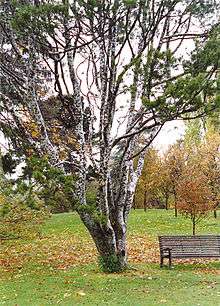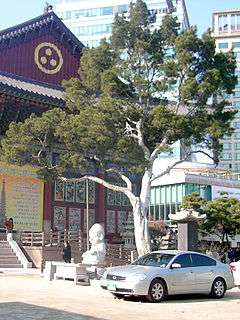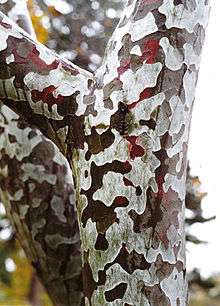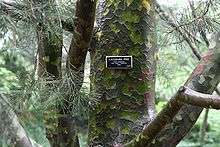Pinus bungeana
Pinus bungeana (English: Bunge's pine[2] or lacebark pine or white-barked pine; Chinese: 白皮松 Japanese: シロマツ, Korean: 백송; RR: baeksong) is a pine tree native to northeastern and central China.[3][4] It is a slow-growing tree that can grow to heights of 15–25m and is frost hardy down to below -26 °C. Its smooth, grey-green bark gradually sheds in round scales to reveal patches of pale yellow, which turn olive-brown, red and purple on exposure to light.


| Lacebark pine | |
|---|---|
 | |
| Lacebark pine to the east of the Main Hall at Jogyesa (Buddhist Temple) in Seoul, South Korea | |
| Scientific classification | |
| Kingdom: | Plantae |
| Clade: | Tracheophytes |
| Division: | Pinophyta |
| Class: | Pinopsida |
| Order: | Pinales |
| Family: | Pinaceae |
| Genus: | Pinus |
| Subgenus: | P. subg. Strobus |
| Section: | P. sect. Quinquefoliae |
| Subsection: | P. subsect. Gerardianae |
| Species: | P. bungeana |
| Binomial name | |
| Pinus bungeana Zucc. ex Endl. | |
Distribution and habitat
Pinus bungeana is native to mountains of China, but is widely cultivated as an ornamental, especially for its attractive metallic bark.[1] It has naturalized in the Sierra de la Ventana of eastern Argentina.

Uses
It is grown as ornamental tree in far eastern oriental classical gardens where it symbolizes longevity. It can also be seen in botanic gardens and often grows with multiple stems. Its bark is especially admired just after rains because of the emphasised contrasting colours of its peeling plates.

References
- Bachman, S. (RBG Kew); Farjon, A. (RBG Kew); Gardner, M. (RBG Edinburgh); Thomas, P. (RBG Edinburgh); Luscombe, D. (Forestry Comm. Bedgebury) & Reynolds, C. (Forestry Comm. Bedgebury) (2007). "Pinus bungeana". IUCN Red List of Threatened Species. 2007. Retrieved 2 June 2013.CS1 maint: ref=harv (link)
- "Pinus bungeana". Natural Resources Conservation Service PLANTS Database. USDA. Retrieved 4 October 2015.
- Fu, Liguo; Li, Nan; Elias, Thomas S.; Mill, Robert R. "Pinus bungeana". Flora of China. 4. Retrieved 2018-08-16 – via eFloras.org, Missouri Botanical Garden, St. Louis, MO & Harvard University Herbaria, Cambridge, MA.
- Earle, Christopher J., ed. (2018). "Pinus bungeana". The Gymnosperm Database.
Further reading
- Li, B. & W. C. Gu (2002). "A study on phenotypic diversity of seeds and cones characteristics in Pinus bungeana". Biodiversity Science. 10 (2): 181–188.
- Sujuan, Guo; Ling Hongqin & Li Fenglan. "Physiological and biochemical basis of rooting of Pinus bungeana cuttings". Journal of Beijing Forestry University. 2004 (2).
External links
| Wikimedia Commons has media related to Pinus bungeana. |
| Wikispecies has information related to Pinus bungeana |
